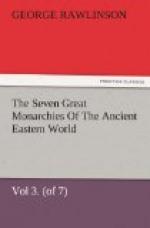The early composition of certain portions of the Zendavesta, which has been asserted in this work, may seem at first sight to imply the use of a written character in Bactria and the adjacent countries at a very remote era. But such a conclusion is not necessary. Nations have often had an oral literature, existing only in the memories of men, and have handed down such a literature from generation to generation, through a long succession of ages. The sacred lore of Zoroaster may have been brought by the Modes from the East-Caspian country in an unwritten shape, and may not have been reduced to writing till many centuries later. On the whole it is perhaps most probable that the Medes were unacquainted with letters when they made their great migration, and that they acquired their first knowledge of them from the races with whom they came into collision when they settled along the Zagros chain. In these regions they were brought into contact with at least two forms of written speech, one that of the old Armenians, a Turanian dialect, the other that of the Assyrians, a language of the Semitic type. These two nations used the same alphabetic system, though their languages were utterly unlike; and it would apparently have been the easiest plan for the new comers to have adopted the established forms, and to have applied them, so far as was possible, to the representation of their own speech. But the extreme complication of a system which employed between three and four hundred written signs, and composed signs sometimes of fourteen or fifteen wedges, seems to have shocked the simplicity of the Medes, who recognized the fact that the varieties of their articulations fell far short of this excessive luxuriance. The Arian races, so far as appears, declined to follow the example set them by the Turanians of Armenia, who had adopted the Assyrian alphabet, and preferred to invent a new system for themselves, which they determined to make far more simple. It is possible that they found an example already set them. In Achaemenian times we observe two alphabets used through Media and Persia, both of which are simpler than the Assyrian: one is employed to express the Turanian dialect of the people whom the Arians conquered and dispossessed; the other, to express the tongue of the conquerors. It is possible—though we have no direct evidence of the fact—that the Turanians of Zagros and the neighborhood had already formed for themselves the alphabet which is found




